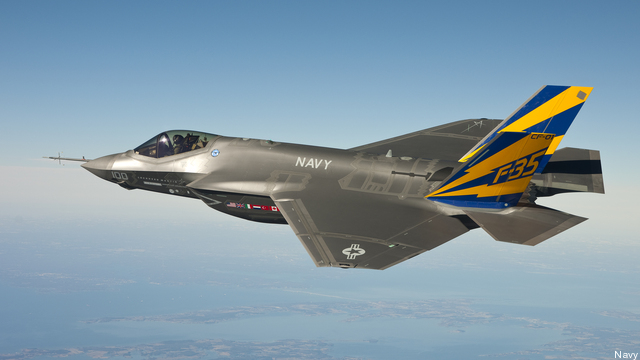CNO Article Raises Doubts About Joint Strike Fighter
Posted on

[This piece was originally published under the title “CNO Ready To Cut Back On F-35 Joint Strike Fighter,” which was factually incorrect; see our note below.]
Chief of Naval Operations Jonathan Greenert’s recent article in Proceedings announces in public what many have already known in private: The U.S. Navy is not wholly committed to the Lockheed Martin F-35 Joint Strike Fighter program. Admiral Greenert’s controversial — and, potentially, hugely consequential — article raises several interesting points, among which is the contention that advances in sensing capabilities and electronic and cyber warfare will increasingly degrade America’s stealth arsenal.
This is not news. What is news, however, is the head of the U.S. Navy signaling a tepid commitment to the military’s largest acquisition program, not to mention the many allied and partner country participants.
It should not come as too big a surprise given the Navy’s objective in last year’s 30-year aviation plan a desire to begin investing in a Next Generation Air Dominance Aircraft after 2019. Accordingly, just last month, the Navy solicited concepts (not yet formal bids) from industry for the F/A-XX, a potential sixth-generation replacement for the F/A-18E/F Super Hornet.
Stealth is not invisibility. As America’s adversaries gain new capabilities, they will increasingly be able to find and target our low and very low observable arsenal. In this sense, stealth and counter-stealth technologies are locked in one of the classic struggles of modern warfare: hiders versus finders. As detection technologies become increasingly effective, the stealth capabilities needed to hide become more and more complex, driving up their cost. Admiral Greenert’s conclusion is that investing in short-range, stealthy systems may ultimately price the U.S. out of the hiders vs. finders competition; leaving America with very few, very expensive systems.
As an alternative, the CNO suggests that stealth is not a silver bullet. But it was never intended to be one in perpetuity. He argues that it may ultimately be more effective to invest in long-range munitions and electronic warfare that could blind enemy sensors, for instance, instead of simply hiding from them.
As DoD Buzz’s Phil Ewing points out, Admiral Greenert seems to imply that the F-35 is the product of the kind of hiders versus finders competition that the United States cannot win.
So is the Navy essentially floating the idea of scaling back its F-35C order in favor of other options like long-range drones? It seems clear the answer is yes. And even if it is not, the Chief’s article demonstrates that the Navy is far from wedded to the largest defense program in the world.
Any reduction by a U.S. service in this international program will cause the entire purchase to be reduced and restructured and costs to spike. The Joint Strike Fighter program is like a sweater in that when any thread is pulled — including reduced purchases, let alone cancellation of a variant — it can cause other parts of the program to fall apart very quickly. The Air Force has already borne the negative consequences of delayed IOC (initial operational capability) date, whose ripple effects are steadily increasing the average age of the Air Force’s inventory while increasing the maintenance bills of legacy fighters that have to fly much longer than originally planned.
While the F-35 program and other stealth capabilities have their liabilities, they also fulfill key requirements-notably those in the opening hours of conflict. Unfortunately, by terminating production of the F-22 prematurely, the Pentagon has backed itself into a corner where the choice is not the F-35 or a more desirable option, but rather, the F-35 or nothing. If the F-35 program is slowly dismantled, the United States may never buy another manned fighter.
The disrupted development of the F-35 stands as a clear lesson for America’s defense planners. Killing needed weapons programs often saves money in the short term, but it creates headaches in the long run when planners are left with sub-optimal choices and no easy way out. Admiral Greenert is to be commended for thinking through issues like the future of stealth in a public forum, but the Navy needs to think very cautiously before signaling to the world they would be just as happy with new capabilities on fifth-generation aircraft rather than the platform itself.
[A note of apology from Sydney J. Freedberg Jr., Deputy Editor, Breaking Defense: When I first posted this article by Mackenzie Eaglen, I hastily titled it “CNO Ready To Cut Back On F-35 Joint Strike Fighter,” which exaggerated Ms. Eaglen’s point and misrepresented Adm. Greenert’s position. After some sharp feedback from both the CNO’s press officer, Capt. Daniel Hernandez, and some of our well-informed readers — both privately and in the comment section below — we’ve decided to correct the title to “CNO Article Raises Doubts About Joint Strike Fighter.” The original, incorrect title was entirely of my choosing, and Ms. Eaglen bears no responsibility for it. My apologies to our readers. — Sydney J. Freedberg Jr.]
Subscribe to our newsletter
Promotions, new products and sales. Directly to your inbox.
